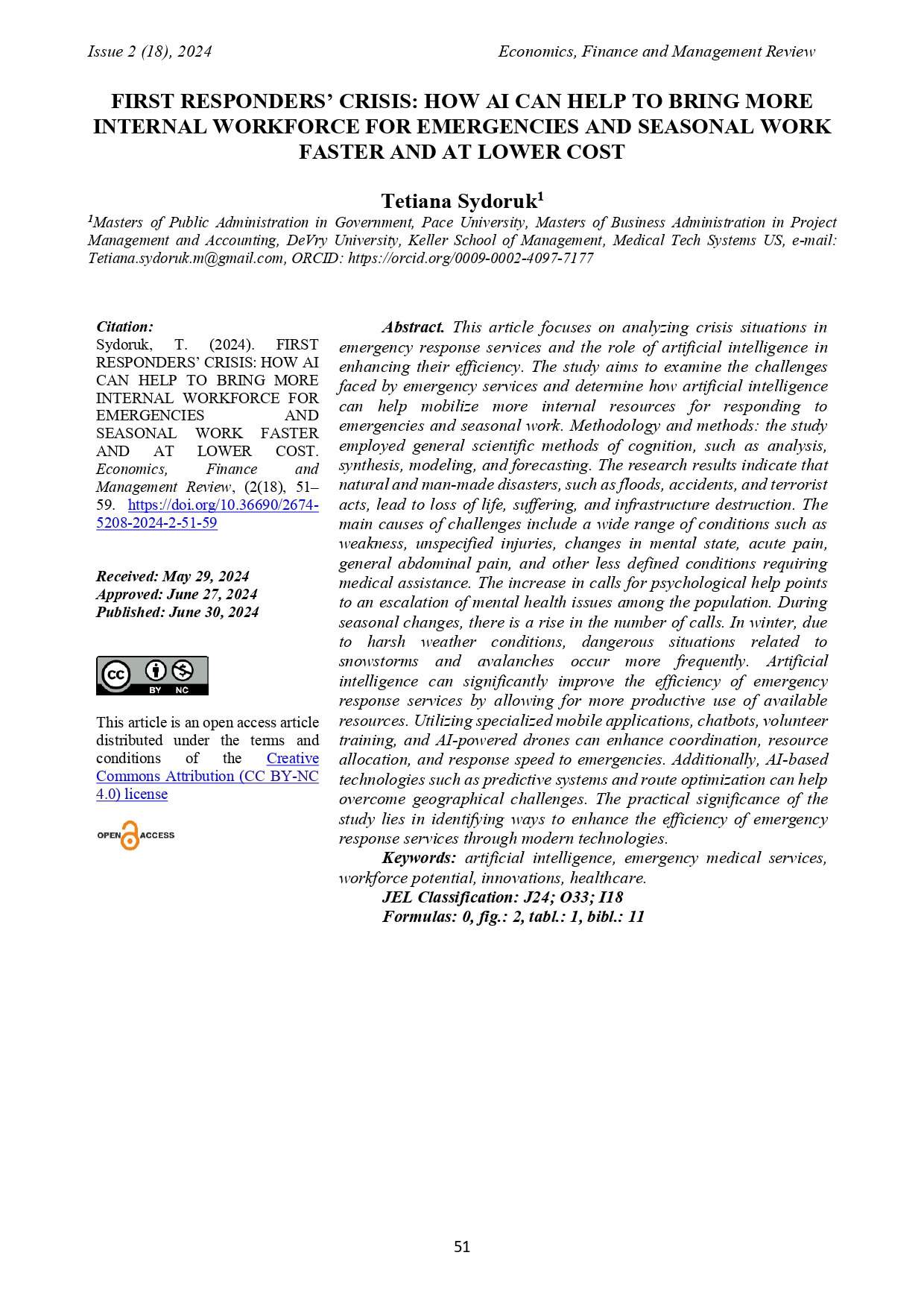FIRST RESPONDERS’ CRISIS: HOW AI CAN HELP TO BRING MORE INTERNAL WORKFORCE FOR EMERGENCIES AND SEASONAL WORK FASTER AND AT LOWER COST
DOI:
https://doi.org/10.36690/2674-5208-2024-2-51-59Keywords:
artificial intelligence, emergency medical services, workforce potential, innovations, healthcareAbstract
This article focuses on analyzing crisis situations in emergency response services and the role of artificial intelligence in enhancing their efficiency. The study aims to examine the challenges faced by emergency services and determine how artificial intelligence can help mobilize more internal resources for responding to emergencies and seasonal work. Methodology and methods: the study employed general scientific methods of cognition, such as analysis, synthesis, modeling, and forecasting. The research results indicate that natural and man-made disasters, such as floods, accidents, and terrorist acts, lead to loss of life, suffering, and infrastructure destruction. The main causes of challenges include a wide range of conditions such as weakness, unspecified injuries, changes in mental state, acute pain, general abdominal pain, and other less defined conditions requiring medical assistance. The increase in calls for psychological help points to an escalation of mental health issues among the population. During seasonal changes, there is a rise in the number of calls. In winter, due to harsh weather conditions, dangerous situations related to snowstorms and avalanches occur more frequently. Artificial intelligence can significantly improve the efficiency of emergency response services by allowing for more productive use of available resources. Utilizing specialized mobile applications, chatbots, volunteer training, and AI-powered drones can enhance coordination, resource allocation, and response speed to emergencies. Additionally, AI-based technologies such as predictive systems and route optimization can help overcome geographical challenges.The practical significance of the study lies in identifying ways to enhance the efficiency of emergency response services through modern technologies.
Downloads
References
Asay, M. (2023). AI’s impact on cost savings, productivity, and jobs. InfoWorld. https://www.infoworld.com/article/3701588/ais-impact-on-cost-savings-productivity-and-jobs.html
Baetzner, A.S., Wespi, R., Hill, Y., et al. (2022). Preparing medical first responders for crises: A systematic literature review of disaster training programs and their effectiveness. Scandinavian Journal of Trauma, Resuscitation and Emergency Medicine, 30(76). 1- 23. https://doi.org/10.1186/s13049-022-01056-8
Doke K., Affinnih, H., Yuan Q. et al. (2021). Improving emergency preparedness and response in rural areas. In ACM SIGCAS Conference on Computing and Sustainable Societies (COMPASS). Virtual Event, Australia. ACM, New York, NY, USA, 13 pages. 66-78. https://doi.org/10.1145/3460112.3471944
George, K., Sweeney, S. (2022). State actions to address EMS workforce shortages. National Conference of State Legislatures. https://www.ncsl.org/health/state-actions-to-address-ems-workforce-shortages
Germann, N. (2023). How businesses are using AI for labor cost reduction. IntelePeer. https://intelepeer.ai/blog/how-businesses-are-using-ai-for-labor-cost-reduction
Mandhani, A. (2023). How artificial intelligence can help workforce. LinkedIn. https://www.linkedin.com/pulse/how-artificial-intelligence-can-help-workforce-ansh-mandhani/
NEMSIS (2021). 2021 NEMSIS National EMS Data Report. https://nemsis.org/2021-nemsis-national-ems-data-report/
Peyton, J. (2023). First responders suffering in silence. Common Group. https://commongroundhelps.org/first-responders-suffering-in-silence/
Powers, J. (2023). IoT technology: Cutting-edge emergency services. CDW. https://www.cdw.com/content/cdw/en/articles/networking/iot-technology-cutting-edge-emergency-services.html
Saunders, H., Guth, M., & Panchal, N. (2023). Behavioral health crisis response: Findings from a survey of state Medicaid programs. KFF: Mental Health. https://www.kff.org/mental-health/issue-brief/behavioral-health-crisis-response-findings-from-a-survey-of-state-medicaid-programs/
The White House. (2022). President Biden to announce strategy to address our national mental health crisis as part of unity agenda in his first state of the union. https://www.whitehouse.gov/briefing-room/statements-releases/2022/03/01/fact-sheet-president-biden-to-announce-strategy-to-address-our-national-mental-health-crisis-as-part-of-unity-agenda-in-his-first-state-of-the-union/

Downloads
Published
How to Cite
Issue
Section
License

This work is licensed under a Creative Commons Attribution-NonCommercial 4.0 International License.








